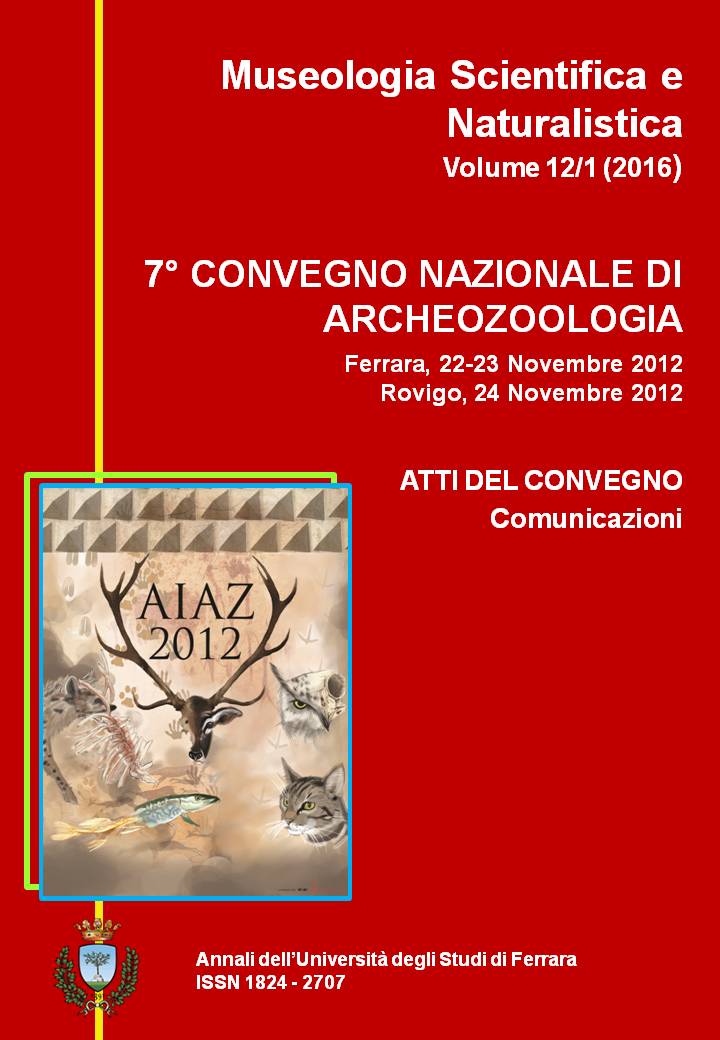Equus ferus e Equus hydruntinus nella serie epigravettiana di Grotta Paglicci (Rignano Garganico – Foggia)
DOI:
https://doi.org/10.15160/1824-2707/1296Abstract
Riassunto - La caccia agli equidi ha rappresentato un'importante fonte di sostentamento a Grotta Paglicci (Rignano Garganico, Foggia) nel corso dell'Epigravettiano. Il cavallo risulta in alcuni casi la specie più abbondante, come nel livello 10e, attribuito alle fasi finali dell'Epigravettino antico, dove è presente tra gli ungulati con oltre il 50% dei resti. Questo equide viene sostituito dall'idruntino in occasione di oscillazioni climatiche più temperate. Questa alternanza risulta ben evidente soprattutto a partire dal taglio c del livello 6 (17386±288 cal. 2σ BP, Epigravettiano finale) fino al tetto della sequenza (13313±191 cal. 2σ BP). La presenza dei resti di idruntino non raggiunge però percentuali elevate (al massimo 29 % nel taglio b dello strato 4, datato 13816±276 cal. 2σ BP). Nei livelli in cui è stato possibile eseguire un confronto, dati preliminari mostrano per il cavallo una maggiore quantità di denti definitivi emergenti e di denti decidui rispetto all'idruntino. Nel taglio a3 del livello 16 riferito all'Epigravettiano antico (19843±208 cal. 2σ BP) ad esempio, il 27,8% dei denti isolati e delle mandibole di cavallo è riferibile a soggetti giovani e subadulti, mentre per l'idruntino le stesse due classi di età non superano il 6,6%. Ciò farebbe supporre una diversa modalità di sfruttamento delle due specie.
Summary - Equus ferus and Equus hydruntinus in the Epigravettian series of Grotta Paglicci (Rignano Garganico - Foggia)
During the Epigravettian, horse (Equus ferus) and Equus hydruntinus represented important resources for the human subsistence at Grotta Paglicci (Rignano Garganico, FG). The horse is sometimes the most abundant species, such as for istance in level 10e (final stage of the Early Epigravettian) where its remains represent the 50% of the NISP among ungulates. This species was replaced by E. hydruntinus during more temperate climatic oscillations. This phenomenon can be appreciated for istance from spit “c” of the level 6 (17386±288 cal. 2σ BP, Final Epigravettian) to the top of the sequence (13313±191 cal. 2σ BP). E. hydruntinus remains are never very abundant (the maximum, 29%, is reached in spit “b” of layer 4, dating back to 13816±276 cal. 2σ BP). When a comparison was possible, preliminary data show that deciduous teeth, or erupting permanent theet, are more abundant among horse remains than E. hydruntinus ones. It was observed for istance in spit A3 of layer 16 (Early Epigravettian, 19843±208 cal. 2σ BP), where the 27,8% of horse isolated teeth and jaws belong to juvenile and subadult individuals, whilst only the 6,6% of the same kind of specimens of E. hydruntinus can be attributed to these age classes. This fact could be related to different exploitation strategies of the two species.



